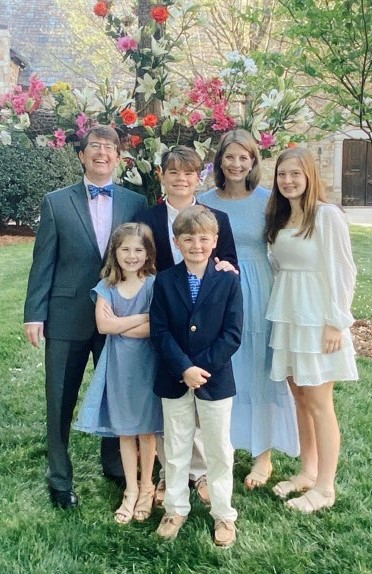Darin worked as a printing press operator and supervisor at a plant in Easley, South Carolina. He got hurt when he attempted to clean an enormous printing machine roller, which spun at about 35 mph. As he wiped the 5-foot-long roller, it violently jerked his hand in. He strained violently and repeatedly to yank it out. He needed all his strength in his arms and legs to rip himself out from it, which also snapped his neck viciously.
Darin suffered a brutal right-hand crush injury causing partial amputations to the index, middle, and ring fingers, which created a complicated, high-stakes case for Darin for two reasons. One, his physical injuries later developed into the excruciatingly painful, largely untreatable condition called complex regional pain syndrome (CRPS).
Two, Darin suffered a psychological injury that was complicated by a prior psychological injury. Darin is a Marine who served in active deployment in the first Gulf War, Desert Shield/Desert Storm, from December 1990 to August 1991. As a result, he sustained post-traumatic stress disorder (PTSD). Insurance companies love to deny benefits for these situations, claiming they’re pre-existing injuries, but that’s just not always the case. To get him workers’ comp benefits, we had to prove his work injury worsened that PTSD.
Initially, things started well for Darin. The workers’ compensation insurance company provided skin grafts to repair his middle and ring finger avulsions, where skin got ripped off.
What Brought Darin to Us
Darin represented himself almost six months before hiring us. By then, he’d grown concerned the insurance company didn’t take his CRPS diagnosis seriously. He’d begun to sense the insurance company wanted to close out his case without giving him much further treatment.
Lucky for us, Darin saw my videos on YouTube. He told me they made him feel like I was a genuine person who truly wanted to help him and educate him about the process, so he didn’t feel like he was still in the dark about what went on in his case.
We went straight to work, getting up to speed ASAP. I recognized Darin’s best hope for maximum benefits at the end of his case meant he needed to satisfy a tough legal hurdle—South Carolina’s two-injury rule.
The Harsh Reality of Complex Regional Pain Syndrome on a South Carolina Workers’ Comp Case
Seeing CRPS’s impact on a Marine sergeant was heartbreaking.
- Virtually any use of his right hand and arm causes unbearable “needle and burning pain.” He describes it as like grabbing a baby cactus in his fingers, which travels into his hand and up his arm to his shoulder, followed shortly by a burning sensation like holding a blowtorch to his hand and moving it from his fingers up his arm to his neck. In the fleeting moments it reduces, it soon comes back—which Darin describes as “waiting on you like a bully at the bus stop.”
- The simplest acts of life are now clumsy, time-consuming one-handed ordeals, like showering and dressing. He wears shoes with straps because he can’t tie them. Eating is an awkward, potentially humiliating affair—he shovels food with a fork in his left hand. If meat needs cutting, he needs someone to do it for him.
- He can’t sleep. He gets about three hours a night before he’s awakened by intense pressure pain like a thousand pounds sitting on the arm that blooms into the burning blowtorch sensation.
- He is extremely sensitive to weather. If the sun hits his arm, it burns like an ant under a magnifying glass. If wind hits it, it’s like frostbite. He always wears hoodies with front pockets to shield his arm and hand.
- His 5-year-old daughter is the light of his life, but he describes caring for her as “massively difficult.” They have to wake up 45 minutes early to give him time to help her dress.
- He states, “I have no life. Zero life.” Darin no longer pursues his active hobbies of running, biking, hiking, working out, fishing, kayaking, and four-wheeling.
We Fight for Care
The CRPS diagnosis brought challenges because it’s highly disfavored, especially by the insurance companies who have to pay for its usually expensive treatment. They claim the pain’s “subjective” because it can’t be measured by a medical test. As you’ve just seen, the effects on Darin were quite real.
Darin’s hand surgeon suspected CRPS when Darin just couldn’t shake the agony. It became clear Darin’s CRPS diagnosis was legitimate when a pain management doctor confirmed it. Pain management with medications and even nerve blocks failed, leaving doctors with only one option: a spinal cord pain stimulator. This is a highly expensive treatment of last resort involving the surgical implantation of a device to send electrical pulses to the spinal cord to mask pain.
As the potential for a spinal cord stimulator slowly became a reality, the insurance company reached into its bag of tricks to prevent it, using its attorney to do it. First, it refused psychological treatment. The insurance company based its denial on the assertion that PTSD was “pre-existing” and related only to his military war service. In response, I set up a phone conference with the psychologist, who established the work injury worsened the war PTSD. I developed a questionnaire from that, showing in a simple yes-or-no format answered by the psychologist that the “pre-existing” argument barked up the wrong tree.
Next, the insurance company asserted the psychologist conditioned approving Darin for the spinal cord stimulator trial on completing an entire course of PTSD treatment. Knowing this could delay the pain stimulator indefinitely, I obtained clarification from the psychologist that he both recommended an immediate stimulator trial and could treat Darin during it. We filed a Form 50 for a hearing to obtain this treatment and the stimulator trial. Before the hearing, the insurance company—which had our questionnaire—agreed to provide the treatment, leading to pain stimulator trial approval and later, implantation of the device.
The Strategy for the Most Workers’ Comp Benefits in South Carolina
Darin needed to satisfy the two-injury rule to qualify for maximum benefits under either permanent and total disability or wage loss. To do that, I closely reviewed medical records to find additional body parts affected by the injury. A critical phone conference with the pain management doctor yielded a questionnaire affirming several involved body parts, including Darin’s fingers and arm. The doctor later testified these parts were affected. I did the same with Darin’s psychologist to prove an injury to Darin’s psyche.
I had to be sure Darin helped the most important witnesses in virtually any case—the doctors. Due to the need to emphasize injuries to other affected body parts and his psyche, I had to be unusually mindful to make sure Darin communicated these injuries clearly to all providers. This resulted in more time invested with Darin, to be sure he understood and expressed that at appointments. I was blessed in this regard—Darin’s very expressive and eager to share his symptoms with doctors because he knows doctors can help the most when they know the full extent of your condition.
We Go the Unexpected Extra Mile
Sometimes cases just require a little extra care, but we’re glad to do it. We help people, not just their cases.
When Darin encountered complications from the stimulator causing more pain than it eased, I ran down the new stimulator representative by calling the pain management doctor to get the rep’s phone number. This helped put an end to an agonizing, overdue wait for Darin to get the stimulator reprogrammed.
With any legitimate psychological injury comes the need to be ever so careful in handling a client who is emotionally wounded. We exercised great care to be compassionate towards him, especially when he called justifiably frustrated and/or depressed.
This was especially true when it looked like his pain stimulator implantation surgery would be delayed after we fought so hard to get it. Due to a communication glitch between the doctors and workers’ comp, scheduling of a pre-op appointment didn’t get put on the doctor’s calendar. We worked feverishly to ease Darin’s fear and outrage, working with the doctor to make that pre-op happen. It did, and he got the stimulator as scheduled.
There Is No Failed Mediation
The severity of Darin’s case required mediation before we could request a final hearing. Mediation required me to spend hours assembling all the evidence in the case, then create a meaningful package to help the mediator and insurance company forge a settlement to achieve Darin’s goals.
At that point, the pain stimulator had proven to be disappointing. Darin had testified that when it works right, “the pain tidal wave overtakes it.”
I look at mediation as trial preparation, so it’s always time well spent. Our extensive mediation brief detailed our proof of permanent total disability plus study-based cost estimates for future medical care. We copied the insurance company’s attorney with it. Some lawyers might think that’s foolish, but I’m convinced it only helps. We have nothing to hide, and it showed we were ready for a hearing with a solid case.
At mediation, we sat around for hours making multiple offers the insurance company countered with almost nothing, despite the mediator’s dogged efforts. At the very end of the day, the insurance company finally got serious, but it still wasn’t enough. It’s clear to me they used this to test our patience and determination. We walked away politely, with no settlement.
I’m convinced our mediation brief helped increase the settlement amount later because it showed we knew what we were doing.
Workers' Comp Settlement Comes as Hearing Looms
As a hearing date approached, the insurance company’s attorney called with an even better offer. While we rejected it, it led to further talks that resulted in a settlement achieving Darin’s goal of financial stability for himself and his family.
It was a long campaign with many battles, but I’m awfully proud I helped this veteran get the care he needed and a settlement he feels good about. Helping someone with profound physical and emotional wounds overcome a hard-fought case against a tightfisted insurance company is a reward itself.


